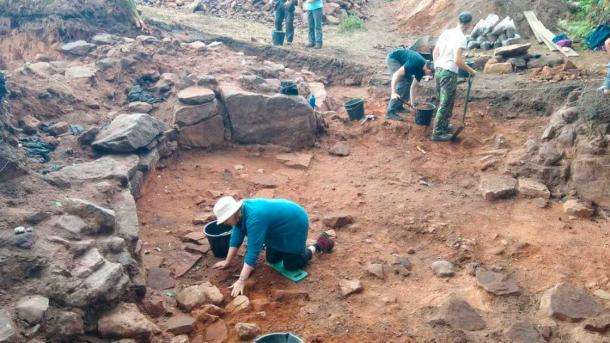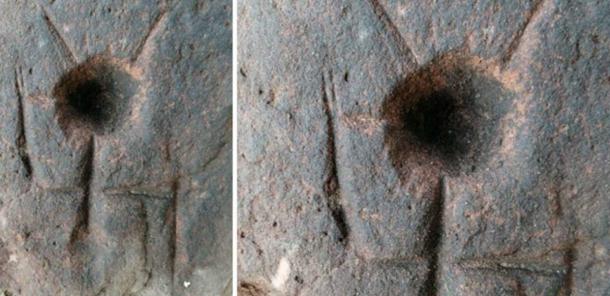The mystery of the Nessglyph riddle continues to elude archaeologists, and they’ve now requested public intervention and help. The curious rock carving on a piece of red sandstone, found last summer during excavations at Nesscliffe Hillfort, has been dated to the Iron Age – roughly 500 BC. It has a peculiar circular shape intersected with straight lines that have been carved with a metal implement. It creates a depiction of a horned figure holding something in its grip.
Roman Occupation and Remains
The site is very interesting because it has also been marked by Roman occupation later on in its history, evidenced by a fair amount of Roman domestic and military pottery from the 2nd century AD.
A lot of precious finds have been lost due to the heavy acidic nature of the soil. In fact, the very site where the glyph was found had been explored in the 1950s and then backfilled, reports local daily My Shrewsbury .
Due to a lack of care in the backfill of the excavation trench within the guard chamber of the entrance, it has been even more difficult to identify and decipher the glyph. This is why the call has been put out for any member of the public to help solve the puzzle or compare it with anything else they’ve seen before.

The 2022 dig had been led by Gary Lock, Emeritus Professor of Archaeology at the University of Oxford. Leading the excavations, he thought the hillfort was built for display and community use, including celebrations and ceremonies, rather than for defense.
“We think the hillfort was built probably more for display (rather than military purposes) – to impress the neighbors!”, he provided. The site had been described as a site of ‘national importance’, likely serving the farming communities of the area.
A Horned Deity Cult?
“The circular cup shape and the straight lines are indicative of two different types of technology, grinding and carving. We can speculate that the Nessglyph is figurative, with the cup mark being the head. It has two long horns and two small horns, a central body line and two arms, one held up and the other down, the upward one showing a possible hand holding a pipe or a weapon,” provided Paul Reilly, a visiting fellow in archaeology at the University of Southampton.

Reilly further explained that it has been difficult to find any parallels from the Iron Age , but the carving has similarities with Late Bronze Age carvings of figures in horned helmets. Nesscliffe lies within the purported territory of Cornovii, a name suggested in reference to the ‘horned ones’. What’s interesting is that the Roman army had a horned deity cult, which has been depicted at several military sites across Britain – perhaps there is a deeper connection to that.
Further examination revealed the circular cup shape and the straight lines to be indicative of two different types of technology – grinding and carving, according to the website of the Shropshire Council . There are alternate theories floating about the Stone Age ‘cup marks’ – potentially used by Druids for blood-sacrifices, or marked by the rising and setting of the sun. Perhaps still, they were meaningless doodles?
The archaeological dig is the result of several years of previous work by Shropshire Council including habitat management, site protection measures, photographic analysis and geophysical surveys.
Rob Gittins, Shropshire Council’s Cabinet member for culture and digital, concluded by saying, “This is an opportunity for people with an interest in our history to get involved and help solve the mystery of the Nessglyph. Nesscliffe Hill Fort has been giving up interesting finds for a number of years and it is fascinating learning about our county’s rich history, especially when it leads to a puzzle such as this.”
Top image: The stone, now known as the Nessglyph, has a circular cup shape and is marked with straight lines carved with a metal implement, looking like a horned deity from the Roman army. Source: Shropshire Council








